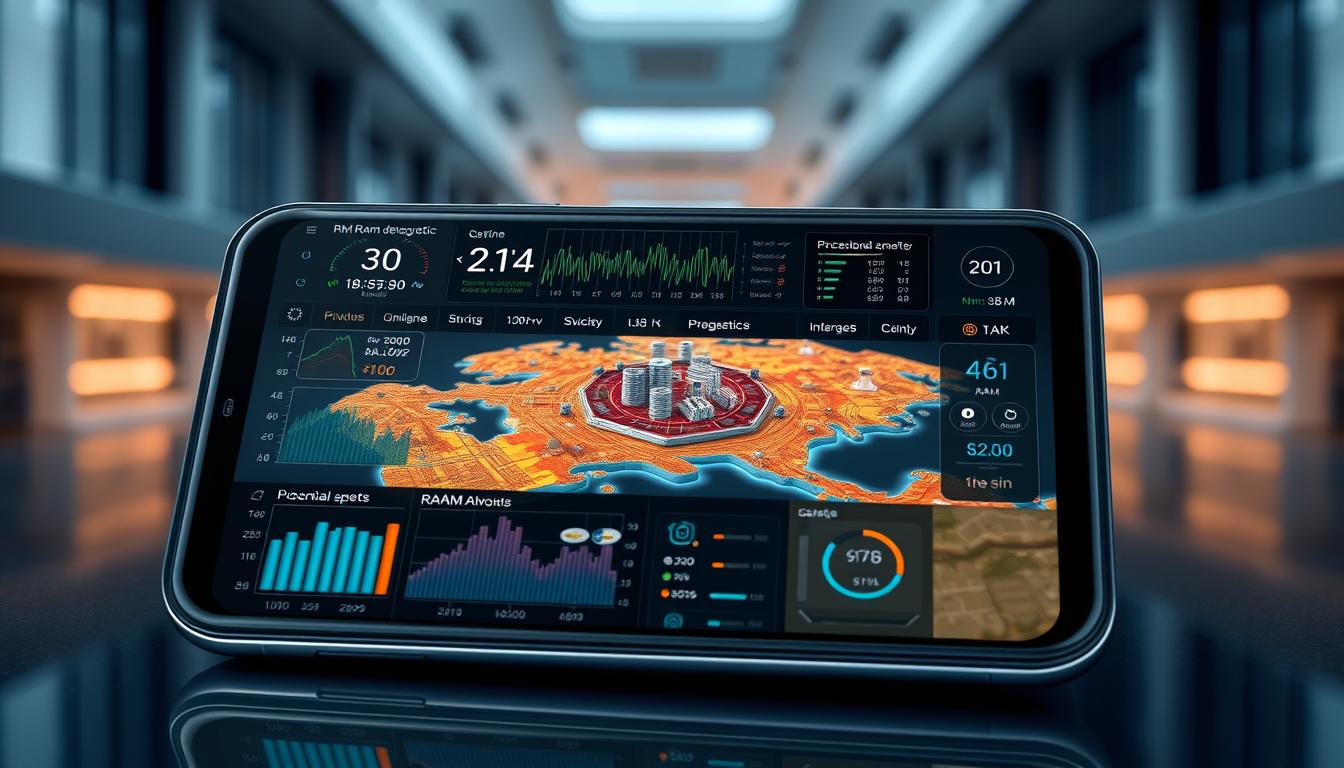Ever wondered how your favorite games remember your progress in changing worlds? The answer often lies in an Efficient Save System for Dynamic Procedural Maps. In Game Development, keeping players engaged means having a system that remembers their journey and adapts to new environments.
This section will dive into the key ideas behind a Modular Save System. It’s designed to tackle the challenges of changing game worlds. We’ll see why it’s crucial for modern gaming.
Understanding Dynamic Procedural Maps
Dynamic Maps are a new way in Game Design. They use Procedural Generation to make environments that change all the time. This method lets developers create levels and worlds with algorithms, not by hand.
This means every time you play, you get a new layout. This makes games super replayable. Players love getting new experiences every time they play.
But, Procedural Generation can make it hard to keep a story straight. Levels can change so much from one play to the next. It’s a challenge to keep the story interesting while still offering surprises.
Creating dynamic maps makes games more interactive. It feels like you’re discovering new things every time you play. Knowing how these maps work helps make save systems that can handle all the changes.

The Importance of Save Systems in Game Development
Save systems are key in game development. They let players keep their progress and wins. Without them, players might get upset and lose interest in the game.
There are many save systems, each with its own good and bad points. Full saves capture everything, letting players pick up right where they left off. Incremental saves let players go back to earlier points without losing their latest wins. Checkpoints save the game at set times, making it easy to start again after a mistake.
These systems keep players hooked and interested. Knowing about different save systems helps developers make games better. In games that change a lot, these systems are especially important. They offer both challenges and chances to make the game more fun.
| Save System Type | Advantages | Disadvantages |
|---|---|---|
| Full Save | Complete progress retention | Can be resource-intensive |
| Incremental Save | Allows for layered recovery | Potential for complexity |
| Checkpoint | Automatic saves promote ease of use | May not capture all progress |

Key Challenges in Save System Design
Creating effective save systems is tough for developers. One big problem is Data Management. Games get more complex, making it hard to track player choices and progress. For instance, procedural maps change a lot with player actions, making data storage tricky.
Another big challenge is Game Complexity. With more detailed game worlds, saving becomes more complex. Players make choices that are hard to predict. This makes it tough to save the game accurately.
The table below shows some major Save System Challenges. It explains how Data Management and Game Complexity play a role.
| Challenge | Description | Impact |
|---|---|---|
| Dynamic Environment | Procedural maps change based on player interactions. | Requires systems to adapt to new states and alterations. |
| Player Decisions | Choices made by players affect the narrative and gameplay. | Complex data tracking is essential for personalized experiences. |
| Data Integrity | Ensuring accuracy of saved data across sessions. | Unreliable saves can frustrate players and lead to loss of engagement. |
| Technical Limitations | Hardware constraints can affect save system performance. | Optimizations are necessary to manage resource usage effectively. |
Benefits of Using a Modular Save System for Procedural Environments
Modular Save Systems bring many benefits to game developers. They make it easier to save specific game states. This lets players keep their progress while trying out different game scenarios.
Another big plus is how easy it is to grow or change the save system. As games evolve, developers can add new features without a big update. This keeps the game running smoothly.
Handling data well is key in game development. Modular Save Systems make data storage more organized. This leads to better game performance, giving players a more enjoyable experience.
The Role of Persistence in Player Engagement
Game persistence is key to keeping players engaged. A good save system makes the game more enjoyable. It lets players explore without worrying about losing their progress.
Players feel more connected to a game with a reliable save system. They can keep playing and improving their skills. This makes them more invested in the game’s world.
A strong save system helps players feel like they’re making progress. It lets them explore and try new things. This leads to a deeper connection with the game.
Technical Requirements for Implementing Save Systems
Creating Save Systems for dynamic procedural maps needs a deep understanding of technical needs. Developers must follow industry-standard Coding Standards. This ensures the system works well on different platforms.
Choosing the right data format for saving game state is key. JSON or XML are good because they are easy for humans to read. But, binary formats might make files smaller and load faster. Developers should pick based on what they need for performance.
Managing file size is also important. Big files can make games load slowly, which is bad for players. Using data compression or breaking game state into smaller parts can help.
Keeping data safe and sound is crucial. This means having good error handling and backup plans. It’s also important to check data for errors to avoid losing it during saves.
Finally, making sure the save system works on all platforms is essential. Testing it against Coding Standards helps. This ensures players have a smooth gaming experience, no matter their device.
Best Practices for Designing Modular Save Systems
Creating effective Modular Save Systems needs careful attention to several Best Practices. Scalability is key; as a game grows, the save system must handle new content well. A flexible architecture lets developers add more data types easily. This keeps the game engaging for players.
Defining clear data structures is crucial. Developers should set up clear formats for game states, character progress, and environmental details. This makes debugging and changes easier. It also ensures all important game elements are saved correctly.
User-friendly interfaces are vital for player interaction. Designing easy-to-use save and load menus makes the process smoother. It also encourages players to use the features, making the game more accessible to everyone.
Finally, thorough testing and validation are essential for a reliable save system. Testing helps find and fix bugs that could ruin the game. This focus on detail makes players trust the system, improving their gaming experience.
Case Study: Successful Implementation in Popular Games
Looking at modern gaming, we see case study examples that show how to do save system implementation right in popular games. Games like “Hades” and “No Man’s Sky” are great examples. They use new ways to handle save data in changing worlds.
“Hades,” a roguelike game, has a save system that lets players pick up where they left off. This keeps players trying new things without getting stuck. It shows how a good save system keeps players interested for a long time.
“No Man’s Sky” takes players on a journey through a huge universe. Its save system keeps track of everything players do, from exploring planets to discovering new things. This lets players dive back into their adventures, knowing their progress is safe.
These case studies teach us that a well-thought-out save system implementation can keep players coming back. As game developers keep pushing the limits, learning from these examples helps make games that really connect with players.
Dynamic Content Generation and Its Impact on Saving Mechanisms
Dynamic Content Generation changes the game world by making new experiences all the time. This new way of making games makes gameplay better but also makes saving harder. Players need to save their progress in a way that keeps up with the game’s changes.
Old save systems can’t keep up with the fast-changing game content. When the game story changes based on what the player does, saving the game’s state becomes crucial. This helps players pick up where they left off without missing a beat.
Good saving systems need to handle many things, like changes in the game world and the player’s quests. Game makers must make these systems flexible to fit each player’s unique journey. This flexibility makes the game more enjoyable for everyone.
Common Pitfalls to Avoid in Save System Design
Creating a good save system is key in game development. Yet, many developers face common problems. One issue is making saving too complicated, which confuses players. A simple and clear save system makes it easy for players to see their progress, avoiding frustration.
Choosing the wrong user interface is another big problem. If players find it hard to save, they might get bored and unhappy. Designs should be easy to use, so players can save their progress without trouble.
Not testing enough is a big challenge in finding game development mistakes. Developers must test save systems in many ways to make sure they work well. A well-tested save system makes the game better, keeping players interested and engaged.
Learning from past mistakes can make future save systems better. Knowing common problems helps developers make stronger and more player-friendly save systems.
Testing and Quality Assurance for Save Systems
Testing and Quality Assurance are key in making Save Systems work well. They make sure these systems are reliable, adding to the fun of playing games. Testing covers many areas to catch problems early, before they bother players.
Unit testing is the first step. It checks each part of the code to make sure it works right. Finding and fixing small errors here helps avoid bigger problems later. Then, integration testing is crucial. It makes sure all parts of the system work well together, fixing any issues that might pop up.
Getting feedback from players is also important. It helps developers see how the Save Systems really work in real games. This feedback helps make the systems better, based on what players actually experience.
Using these testing methods makes Save Systems stronger. Games become more reliable and easier to use, cutting down on player frustration. Good Quality Assurance makes sure save features work smoothly, making players happier.
Future Trends in Save System Technology
The world of game development is changing fast, especially in save system tech. New trends are making games more convenient and fun. Cloud saving solutions let players access their data on any device. This makes it easy to pick up where they left off, no matter where they are.
Advanced data analytics are also key. They help developers create games that players love. This personal touch makes games better and keeps players coming back. Plus, artificial intelligence is making save systems smarter. AI can manage data better and suggest games based on what players like.
As game development keeps getting better, these trends will become even more important. A good save system is crucial for games to succeed. Developers who want to lead the way should focus on these new technologies. This will make their games better and keep players happy.
Conclusion
Effective save system design is key in modern game development. It’s especially important in games with dynamic maps that change based on player actions. This article showed how important save systems are for keeping players engaged.
Save systems let players pick up where they left off, keeping them interested in the game. This makes players feel like they’re part of a bigger story.
Developers face challenges when making these systems. But with careful planning and the right strategies, they can overcome these hurdles. By following best practices and staying up-to-date with trends, they can create save systems that work well with the game.
As games keep getting more complex, save systems will become even more crucial. Developers need to keep improving their designs. This way, they’ll meet today’s needs and be ready for tomorrow’s.
FAQ
What are dynamic procedural maps?
Dynamic procedural maps use algorithms to create game levels and environments. This makes every playthrough unique. It adds replay value but might make stories harder to follow.
Why are save systems important in games?
Save systems are key because they let players keep their progress. They help keep achievements and make games more enjoyable, especially in complex worlds.
What types of save systems are commonly used in games?
Games often use full saves, incremental saves, and checkpoints. Each type helps players manage their progress in different ways.
What challenges arise when designing save systems for procedural environments?
Creating save systems for procedural environments is tough. It involves managing data, adapting to gameplay changes, and handling player choices in a changing world.
What is a modular save system, and what are its benefits?
Modular save systems let developers save game states flexibly. They adapt easily and reduce data redundancy. This boosts performance and user experience in dynamic environments.
How does player engagement relate to save systems?
Save systems greatly affect player engagement. Reliable save systems make players feel like they’re making progress. This encourages them to keep playing.
What technical aspects should developers consider for implementing save systems?
Developers need to think about programming standards, file size, data formats, and performance. These are key for building strong save systems in procedural environments.
What best practices should be followed when designing modular save systems?
For modular save systems, focus on scalability and clear data structures. Make sure the interface is user-friendly. Thorough testing is also crucial for a reliable player experience.
Can you provide examples of games with effective save systems?
“Hades” and “No Man’s Sky” are great examples. They use modular save systems well. This keeps players engaged in their ever-changing worlds.
How does dynamic content generation impact saving mechanisms?
Dynamic content generation requires save systems that adapt to changes. This ensures saves work well with shifting narratives and gameplay.
What are some common pitfalls in save system design?
Avoid complex structures, poor interfaces, and inadequate testing. These can frustrate players and ruin the gaming experience.
Why is testing essential for save systems?
Testing is crucial for save systems to work right. Use unit testing, integration testing, and player feedback to find and fix issues. This keeps the game stable and enjoyable.
What future trends are emerging in save system technology?
New trends include cloud saving, data analytics for player behavior, and AI integration. These advancements aim to enhance player experiences in dynamic environments.




